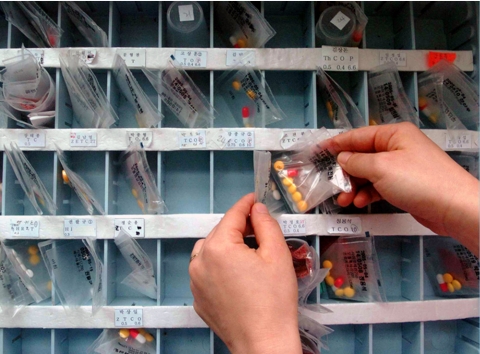Abstract
Leaping from the periodic table to the petri dish, from clinical studies to policy, Clif Barry battles the obstacles involved in eradicating tuberculosis (TB) from multiple fronts.
Clif Barry with feathered friend Jade.
TB remains neglected compared with other infectious diseases, even though it's a leading killer in impoverished nations. For over a decade, Barry has been coaxing people to collaborate in the name of TB elimination (1). At the NIH, he and his colleagues study the metabolism of Mycobacterium tuberculosis (Mtb) within the host cell (2). Their work has revealed ways to suffocate both replicating and nonreplicating Mtb with drugs like PA-824, which is currently in clinical trials (3). By analyzing the Mtb genome and the crystal structure of its proteins, Barry has identified how specific molecules mediate drug sensitivity (4) and how glycolipid antigens manipulate the immune response (5).
MONEY ISN'T THE ONLY HURDLE
Has the funding situation improved for TB over the last decade?
Ten years ago it was all talk and no money. Now there's actually money on the table.
Do you think the situation will continue to improve under the new administration?
There's certainly been a lot of the right noise. I don't want to guess what will happen with the economic stimulus package, but for the first time, the NIH is being considered as part of an economic stimulus plan. It's a logical match because that money will be spent on research and development and it will also create jobs.
Have recent global initiatives calling for TB eradication delivered more than rhetoric?
They definitely help. I think we're gradually learning how to do big science. These kinds of efforts take a lot of different skill sets, and I think that the real impact of the big programs from the Gates Foundation, NIH, and the European Union is to bring together people who might not otherwise collaborate.
Is the mouse model sufficient for human drug design?
That depends on who you ask [laughs]. The problem is that our pathway to develop drugs in the past has always gone through mice. So it's no surprise that when you look at existing drugs, the mice predict how the drug acts in humans, because otherwise they wouldn't have been used in the first place. It's a self-fulfilling prophecy.
My bias is that the human disease looks nothing like the mouse disease. Pathologically, you don't see the same spectrum of lesions. Mice don't even normally get tuberculosis, and so it's not a great leap of logic to say that drug activities will differ between the two.
What's so tricky about developing a TB vaccine?
All the vaccinologists will accuse me of using this as a cop-out answer, but I'll say it anyway. One of the trickiest things about TB is that there is no natural immunity to reinfection. People get reinfected all the time. I think if exposure to the normal bacteria doesn't confer any protective advantage on the host, then you're going to have to do something better than the immune system normally does. And that's a tall order.
Do you think academics devote too much attention to fundamental research and too little time searching for promising drug targets?
Yes, but then I'd also turn around and criticize the industry people for doing too much preclinical research and not enough fundamental research. I think there are big conceptual gaps in understanding what is an effective target and what is an appropriate intervention point. I can't tell you how many times I've been approached by industry people who want to do something for TB and say, “Just give us a target and we'll design you an inhibitor with drug-like qualities.” And I'll turn to them and say, “If I had a good target, this problem would be over.”
ONE BYZANTINE BUG
One-third of the global population carries latent TB. How important is it to reduce that number?
Latent disease is a funny concept. People have historically considered TB to have two states, latent or active, meaning the bacteria is replicating or not replicating. But there seems to be a spectrum of disease states, where we have everything from genuinely sterile scars of infection to permanent disease. As the definition stands, when we say latency, we mean that a person has no signs or symptoms of tuberculosis, but they have a delayed-type hypersensitivity response to subcutaneous implanted antigen from tuberculosis. All that says is that a person has seen the antigen before, but they're not sick.
But if you look at those patients carefully, some may have been exposed to the disease decades ago and their immune system took care of it. Whereas other patients have clinical disease but it's developing slowly. You won't find bacteria in their sputum, they're not running a fever, no night sweats, no classical signs of tuberculosis—but they are on their way. What I'm interested in is trying to understand how to identify people who are truly at risk for the disease, so we can treat them with the appropriate prophylaxis.
Packets of daily drugs for patients with TB in South Korea.
Has decoding the Mycobacterium tuberculosis (Mtb) genome led to new drugs?
I don't think there's any example in the drug area yet. There certainly is in the diagnostics area. There's a test called QuantiFERON that's now FDA-approved for diagnosing TB in lieu of doing the classical PPD test.
Drug-wise, it's a complicated situation. Everybody asks the same questions: What are the essential genes? I think I'll go to my grave at this point saying there's no such thing as a nonessential gene, we just don't understand when it's essential.
What about genetic redundancy?
I struggle with the concept of redundancy. For example, the Leprosy bacillus has lost the ability to grow outside of a human being. And as a consequence, although it's closely related to Mtb, it has lost more than half of its genes because it doesn't need them when growing inside a human. If there were really completely redundant genes, Mtb would've undergone the same process. So I think at some point in its life cycle, although we may not understand when that point is or what those conditions are, virtually every gene is essential.
I completely discount the idea that you should prioritize things based on what is essential for aerobic growth on glucose in a laboratory. But people don't like that idea, because they like to keep it simple.
People respond differently to Mtb infection, is that on account of variation in the human genome or variation in the bacterial genome?
I think both. Every two months we hear about a new genetic polymorphism that's associated with TB in this population or that population. But what we miss when we consider it just from the human side is that the bacteria are evolving—probably faster than we are. And so when we measure human genetic susceptibility, those genes may have been selected by the bacterial strain that was prevalent in the area 20 years before. Mtb has evolved virulence attributes—it's not just constructed of simple things like proteins but complex lipids.
What makes a lipid-laden bacterium so special?
Let me give you one example: The phenolic glycolipid of TB is expressed in the Beijing strains—which everyone thinks are hyper-virulent—while in many other strain types they're not expressed at all. These lipids are surface exposed, they're glycosylated, and they're obviously important. If we take a strain expressing [phenolic glycolipid] in the mouse, we get mortality in that mouse very rapidly. If the only thing we genetically change in the strain is blocking production of that lipid, the mice live as though they weren't infected. And so we know [the lipid] is interacting with the immune system, and we know that it's variable in strains that are circulating globally. We just don't know what the impact is on actual disease progression.
A CHEMICAL ATTRACTION
You're active in TB policy, serving as an advisor to the Global Alliance for TB Drug Development and the World Health Organization. Why take on the extra work?
It was something I wanted to do. I was drawn into the bigger picture because it helped me to understand what we needed to do in the laboratory to really make something useful to people who treat and diagnose TB.
What were you doing before you got into tuberculosis?
I was working on Chlamydia right before I got into TB.
Why did you switch?
It was kind of switching back, actually, because I came out of a chemistry background. I did my graduate work at Cornell in a chemically oriented laboratory, and then a postdoc at Johns Hopkins in another chemically oriented laboratory. I had gotten frustrated with just doing the chemistry; I wanted to be able to do some of the biology, too.
How is chemistry related to your switch from Chlamydia to TB?
Ah, you have to appreciate it from a chemist's perspective. If you're a chemist looking into bacterial diseases, and you see that TB has these amazing, 80-carbon-long lipids with cyclopropanes and all of this fancy chemical decoration, you say, “Wow, what a bug.” And that was before I even really knew how important TB was.
References
- Young D.B. 2008. J. Clin. Invest. 118:1255–1265. [DOI] [PMC free article] [PubMed] [Google Scholar]
- Boshoff H.I. 2005. Nat. Rev. Microbiol. 3:70–80. [DOI] [PubMed] [Google Scholar]
- Singh R., et al. 2008. Science. 322:1392–1395. [DOI] [PMC free article] [PubMed] [Google Scholar]
- Manjunatha U.H., et al. 2006. Proc. Natl. Acad. Sci. USA. 103:431–436. [DOI] [PMC free article] [PubMed] [Google Scholar]
- Reed M.B., et al. 2004. Nature. 431:84–87. [DOI] [PubMed] [Google Scholar]




